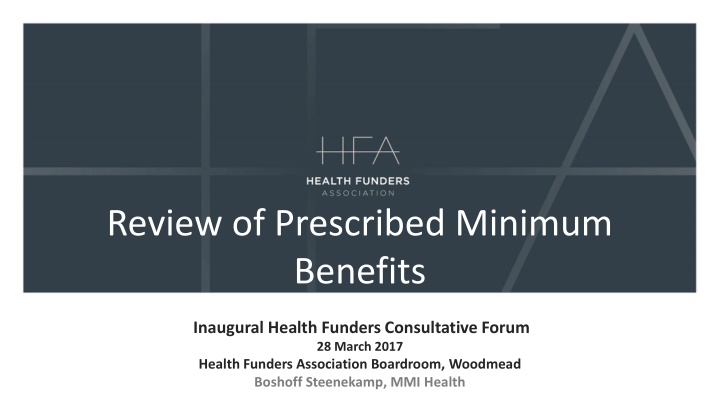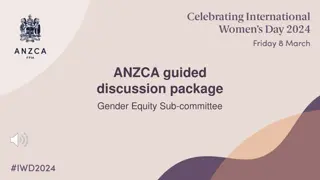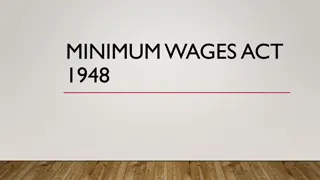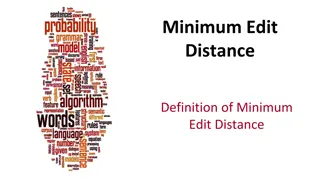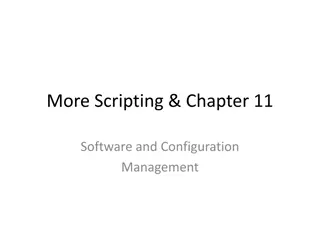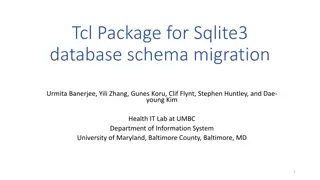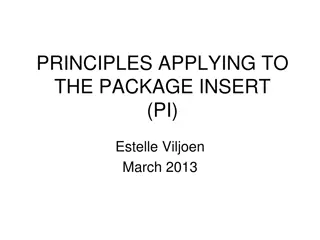Review of Challenges in Prescribed Minimum Benefits Package
Addressing the challenges faced in the Prescribed Minimum Benefits (PMB) package including policy uncertainty, potential interventions for Universal Health Coverage, PMB review process, and sustainability of interventions. Factors contributing to challenges such as tariff determination, fee-for-service remuneration, unclear benefit definition, and lack of incentives for health improvement are discussed. The policy uncertainty and historical health policy developments are also examined.
Download Presentation

Please find below an Image/Link to download the presentation.
The content on the website is provided AS IS for your information and personal use only. It may not be sold, licensed, or shared on other websites without obtaining consent from the author.If you encounter any issues during the download, it is possible that the publisher has removed the file from their server.
You are allowed to download the files provided on this website for personal or commercial use, subject to the condition that they are used lawfully. All files are the property of their respective owners.
The content on the website is provided AS IS for your information and personal use only. It may not be sold, licensed, or shared on other websites without obtaining consent from the author.
E N D
Presentation Transcript
Review of Prescribed Minimum Benefits Inaugural Health Funders Consultative Forum 28 March 2017 Health Funders Association Boardroom, Woodmead Boshoff Steenekamp, MMI Health
Content Challenges with the PMB package Policy uncertainty potential interventions towards Universal Health Coverage Proposed PMB review Process Formal priority setting process Iterative, transparent, participative this reform requires broad acceptance by all participants Elaborate, complex, technically difficult high risk of failure Sustainability interventions Proposed package Conclusion
Incidence trend for PMB- and non-PMB mood disorder claims 450 Condition count index: Base 400 350 300 250 2007 200 150 100 50 0 2007 2008 2009 2010 2011 2012 2013 2014 PMB Non-PMB Adapted from: Raath, Christoff. Prescribed Minimum Benefits Impact Analysis. Presentation to the Department of Health. s.l. : Insight Actuaries, 12 November 2014.
Specialist cost per life index (Real terms) 200 Real cost per life index: Base 150 100 2007 50 Reference price set 0 2007 2008 2009 2010 2011 2012 2013 2014 PMB Non-PMB Adapted from: Raath, Christoff. Prescribed Minimum Benefits Impact Analysis. Presentation to the Department of Health. s.l. : Insight Actuaries, 12 November 2014.
Contributing factors to PMB challenges Tariff determination, fee-for-service remuneration Unclear definition of benefit No incentives to maintain and improve health Hospicentric no primary care Fee-for-service remuneration No coordinated and comprehensive approach to priority setting
Policy uncertainty Potential interventions towards Universal Health Coverage
Health policy developments Taylor committee report (2002) Introduction of REF halted (2008) Green paper on National Health Insurance (2011). Advisory committee established, report not in public domain Draft White Paper on NHI (2015) Reports of task teams not in public domain
Health system challenges Functions Intermediate objectives Coverage goals Creating resources Equity in resource distribution Utilisation in relation to need Stewardship, governance, Revenue collection Financing oversight Benefits Financial protection and equity in finance Pooling Efficiency Purchasing Transparency and accountability Quality Service delivery Steenekamp, Boshoff. Review of South African healthcare financing: towards Universal Health Coverage. A contribution towards the debate on achieving Universal Health Coverage in South Africa. Centurion, South Africa : MMI Health, 15 July 2016. McIntyre, Diane and Kutzin, Joseph. Health financing country diagnostic: a foundation for national strategy development. Health Systems Governance & Finance. Geneva : World Health Organization, 2016. ISBN 978 92 4 151011 0.
A health financing strategy should define changes to revenue raising, purchasing, benefitdesign, and overall system architecture and governance to address specific, identified problems that limit progress towards UHC(final and intermediate) objectives and provide a solid foundation for future development of a system that can be feasibly implemented given current and expected future contextual constraints. Joe Kutzin, Study material, WHO advanced course on health financing for universal health coverage for low and middle income countries.
Interventions towards UHC Service delivery, creating resources, stewardship, governance and oversight Revenue collection Pooling Purchasing Benefits Single health information platform Risk adjustment mechanism for medical schemes Norms and standards for equitable financing in provinces Priority setting authority (NICE or HITAP) Coding, remuneration, and outcomes authority Transversal contracts for medicines, surgicals, labs and equipment Prepare for a purchaser provider split, improve service delivery State sponsorship for missing middle Stewardship, governance and oversight Creating resources Revenue collection Virtual single risk pool Single health information platform Based on: MMI Health.MMI Comments on NHI White Paper. Pretoria: MMI Holdings, 31 May 2016.
Potential cost-containing policy interventions achievable through the PMB review Based on: Moreno-Serra, Rodrigo. The impact of cost-containment policies on health expenditure. [book auth.] OECD. Fiscal Sustainability of Health Systems. Bridging Health and Finance Perspectives. Paris : OECD Publishing, 2015.
Impact of unqualified access to medicines Thiboonboon, Kittiphong, et al., et al. f1000research.com. Policy Brief: Reaching the low-hanging fruits of Vietnam s Health Benefit Package reform [version 1; not peer reviewed]. [Online] March 1, 2017. https://f1000research.com/documents/6-203.
Sequencing of the process Provide clarity on policy objectives Consider approaches to identify priority interventions that must be included in the package Define the package based on an agreed upon prioritisation mechanism Develop clinical guidelines inclusive of algorithms for chronic disease management, screening for public health priorities and diagnostic guidelines Cost the revised PMB package Estimate the affordability level
Proposed governance structure PMB review Steering Committee Representative advisory body Project Manager Actuarial and Economic stream Clinical stream Legal stream Multiple clinical advisory committees Costing team Affordability assessment team
Identify priority services Service 1) Maternity & new born care 2) Primary prevention and secondary prevention 3) Chronic disease management 4) Reproductive services 5) Comfort care 6) Fatal conditions, where treatment is aimed at disease modification or cure 7) Nonfatal conditions, where treatment is aimed at disease modification or cure 8) Self-limiting conditions 9) Inconsequential care Weight 100 95 75 70 65 40 20 5 1 Oregon Health Services Commission. Prioritization of Health Services. A Report to the Governor and the 74th Oregon Legislative Assembly. Oregon.gov. [Online] 2007. [Cited: 5 February 2017.] https://www.oregon.gov/oha/herc/Documents/2007-09%20Biennial%20Report%20to%20Governor%20and%20Legislature,%20June%202007.pdf.
Consider impact on health and social security Oregon Health Services Commission. Prioritization of Health Services. A Report to the Governor and the 74th Oregon Legislative Assembly. Oregon.gov. [Online] 2007. [Cited: 5 February 2017.] https://www.oregon.gov/oha/herc/Documents/2007- 09%20Biennial%20Report%20to%20Governor%20and%20Legislature,%20June%202007.pdf.
Example of outcome of the prioritisation process Oregon Health Services Commission. Prioritization of Health Services. A Report to the Governor and the 74th Oregon Legislative Assembly. Oregon.gov. [Online] 2007. [Cited: 5 February 2017.] https://www.oregon.gov/oha/herc/Documents/2007- 09%20Biennial%20Report%20to%20Governor%20and%20Legislature,%20June%202007.pdf.
Examine impact on affordability The nature and of scope the package significantly influenced by sustainability measures Use Living Conditions Survey data: Estimate affordability to households and impact on membership numbers Use model to determine final scope of the Low Cost Benefit Options Living Conditions of Households in South Africa.An analysis of household expenditure and income data using the LCS 2014/2015. Statistics South Africa. Pretoria : Statistics South Africa, 27 January 2017. Statistical release P0310.
PROPOSED SUSTAINABILITY INTERVENTIONS
Sustainability measures for consideration Create primary care teams Employment of health professionals by hospitals Tariff determination and reimbursement mechanisms Availability of vaccines, medicines, disposables and laboratory services at state tender prices Clinical coding systems and groupers Incentives to focus on improved health Protection of risk pools
Package design Out of hospital In hospital Specialist care 1) Maternity & new born care 2) Primary prevention and secondary prevention 3) Chronic disease management 4) Reproductive services 5) Comfort care 6) Fatal conditions, where treatment is aimed at disease modification or cure 7) Nonfatal conditions, where treatment is aimed at disease modification or cure 8) Self-limiting conditions 9) Inconsequential care Basic NHI package NHI basic package Low cost benefit options Address public health priorities Low cost, high frequency, predictable events Supplementary package Comprehensive package High cost, unpredictable, low frequency events Protect risk pools Financial protection for catastrophic events
Ensure strict adherence to all relevant legislation Consultation is critical Wider than the Minister, CMS and industry stakeholders. Must involve the provinces and members of the public. Ebersohn judgement which set aside the RPL regulations provides guidance on the depth of consultation required
Conclusion The proposed PMB review process is very complex and will require a lot of effort by many stakeholders. Because PMBs have a large impact on many stakeholders, it is important that the process is participative, transparent and legally sound.
